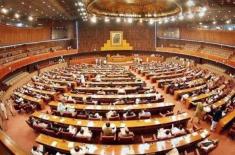
Air Marshal (R) Masood Akhter Reveals Inside Story Of Operation Bunyanum Marsoos
Umer Jamshaid Published May 17, 2025 | 07:50 PM

ISLAMABAD, (UrduPoint / Pakistan Point News - 17th May, 2025) Air Marshal (Retd) Masood Akhter, in an exclusive interview with the web tv of Sustainable Development Policy Institute, laid bare the operational details, strategic decisions, and broader geopolitical implications of Operation Bunyanum Marsoos, the largest aerial confrontation in South Asia since the 1971 war.
For the first time, a former senior officer confirmed that during the height of Pakistan-India standoff, two of India's four S-400 air defense batteries, which were installed near the eastern front, were neutralized by a JF-17 Block II aircraft of the Pakistan Air Force (PAF), escorted by J-10C fighter jets. The destruction of these batteries, he claimed, not only shifted the military balance but also forced India to seek urgent international mediation, appealing to Washington, Ankara, and Riyadh for a ceasefire.
“It was a small miracle,” he said and added: “We had to protect our boys from S-400s while engaging in a one-hour-long beyond-visual-range (BVR) dogfight. It had never happened before and is a new history in the making.”
The decapitation strike on the Indian S-400 systems was executed using CM-400AKG high-speed anti-radiation missiles, launched from JF-17 Block II platforms, with J-10Cs providing electronic warfare support and top cover, he elaborated.
He went on to say that Indian combat air patrols scrambled Sukhoi-30MKIs, Mirage-2000s, and MiG-29s, but were reportedly outgunned by Pakistan’s better-ranged PL-15 BVR missiles onboard the J-10C, whose AESA radar systems were said to be superior to even the Rafale’s much-vaunted Meteor missile.
At least five Indian aircraft were downed, including two Rafales, a Su-30, and a MiG-29, with confirmed ejections observed by third-party systems such as Martin-Baker ejection logs, said Air Marshal (R) Akhter.
He recounted how Pakistan exercised extreme restraint, deliberately avoiding strikes on high-value Indian command centers like Rajouri Brigade Headquarters and Naushera Depot, to prevent uncontrolled escalation. “Our pilots had the target symbols locked. At the last moment, they shifted the aim points by 4–5 kilometers. That’s how close we came to a full-scale war.
”
The former PAF official praised Air Chief Marshal Zaheer Ahmed Baber Siddhu for his “transformational leadership,” including fast-tracking the induction and deployment of J-10C aircraft into frontline operations within six months, orchestrating hundreds of sorties post-engagement to maintain air superiority over key zones, establishing a new Cyber Command and three aerospace technology parks to boost indigenous capability in electronic warfare, drones, and satellite surveillance.
He emphasized that this war was different in its full-spectrum involvement of air, cyber, and electronic domains, including GPS spoofing of enemy drones and soft/hard kills on UAVs targeting Pakistani installations.
He disclosed that Chinese defense attachés visited Air Headquarters the day after the conflict, reportedly to “thank” Pakistan for the real-world trial of the J-10C platform, which outperformed its Western competitors.
“Toward the end of the interview, he shifted his focus from tactics to nation-building, calling for institutionalized coordination among the three services to ensure rapid response in any future crisis, clear political interpretation of India’s so-called “new normal,” and urgent investments in niche technologies, especially via Chinese partnership, to ensure long-term self-reliance in defense and cyber capabilities.
Stressing the need for unity among Pakistan’s fractured sociopolitical landscape, he called for national reconciliation, curriculum reform, and a return to founding principles as defined in Misaq-e-Madina, 11th August 1947 speech of Quaid-e-Azam Muhammad Ali Jinnah, and the last sermon of Prophet Muhammad (PBUH).
When asked if this was just a temporary pause in hostilities, Akhter gave a stark warning: “We may have bought six months. That’s it. We must use this time to get our act together—militarily, politically, and socially.”
His final remarks underscored the fragility of peace and the urgency of preparedness: “The battlefield has changed. The weapons have changed. Unless we unite as a nation, all the missiles, jets, and cyber commands cannot save us.”
Recent Stories

Ayyala Dance: A Symbol of Emirati Unity, Pride and Hospitality – Performed Dur ..

Neeraj Chopra Shatters Barriers: A 90.23-Meter Masterclass in Qatar

Currency Rate In Pakistan - Dollar, Euro, Pound, Riyal Rates On 17 May 2025

Today Gold Rate in Pakistan 17 May 2025

NA passes Income Tax Amendment Bill 2024 amid PTI opposition

Youm-e-Tashakur being observed today to pay homage to armed forces

Talat Hussain's daughter Tazeen ties the knot for second time

Currency Rate In Pakistan - Dollar, Euro, Pound, Riyal Rates On 16 May 2025

Today Gold Rate in Pakistan 16 May 2025

Secretary Information, Quetta Commissioner Hamza visits Balochistan Directorate ..

Three killed, one injured in different incidents in Attock

Youm-e-Tashakur, national flag hoisting ceremony to be observe on Friday
More Stories From Pakistan
-
Malik Abrar praises information ministry promoting national narrative in war
3 seconds ago -
Scorching heat tests citizens’ endurance
4 seconds ago -
President lauds professional excellence of armed forces
10 minutes ago -
Punjab Police female officer wins international award
10 minutes ago -
Air Marshal (R) Masood Akhter reveals inside story of Operation Bunyanum Marsoos
10 minutes ago -
Tank Police launch massive search operation after govt official abduction
10 minutes ago
-
DPM, Turkish FM discuss regional developments
10 minutes ago -
PM targets $125bn agri exports by 2030: Minister Rana Tanveer
30 minutes ago -
Railway Police arrest thief, recover cash
30 minutes ago -
Minister meets ulema, stresses unity, law enforcement
30 minutes ago -
Governor vows to resolve TDPs' issues
40 minutes ago -
DPO Gujrat holds open court
50 minutes ago